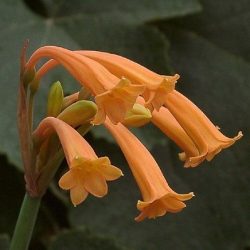
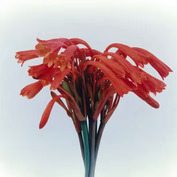
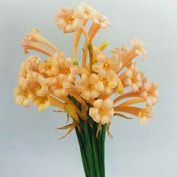
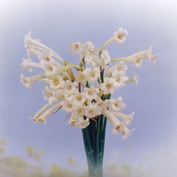
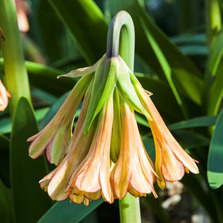
Cyrtanthus
Cyrtanthus is a genus of about 60 species of which about 50 are found in South Africa. Their habitat ranges from cliff faces to forests, down to coastal dunes and the dry Karoo and some are even found in the lofty Drakensberg Mountains.
We have shied away from advertising the more difficult to grow species. All the C. mackenii/macowanii complex species do best in partial shade and are frost-tender. Plant in well-draining soil and bury the bulbs up to their necks. Water well in spring and summer. If dug up and allowed to partially dry out after flowering, they will return to flowering about 6 weeks later. Do not do this more than once per annum as the stress can kill off your bulbs.
Of all the Cyrtanthus listed below, only C. obliquus and speciosus do not need shade, plenty of water and rich compost soil. Both need to dry out between waterings, need coarse sandy soil and need to be planted partially exposed. In Natal, all the Cyrtanthus listed below are evergreen, but you should still allow the water intake to decrease in winter without letting the bulbs completely dry.
The Green Goblin breeding programme is trying (and succeeding) in developing Cyrtanthus clones and hybrids that are not difficult to grow and maintain. Far too many people are conned into buying a pretty bulb that has been stimulated into coming into bud. The average home does not have the facilities to induce a second crop of flowers. We shy away from such practices. If a bulb cannot flower under normal garden conditions, we have refrained from offering it. This way we are confident that you will have years of flowering pleasure and our reputation will remain intact.
After trying our Cyrtanthus range we know you will want to stock the entire spectrum of colours and shapes.

Cyrtanthus mackenii "Alexandra"
This is by far my favourite clone/hybrid; a result of a 3-way crossing of evergreen parents. I made it in the late 1990’s and it’s named for my eldest daughter. It gets up to 11 flowers per stem. Very easy to grow and it will flower at least once every year. It enjoys living in a crowded flower pot.

Cyrtanthus mackenii "Orange"
We took the Cyrtanthus mackenii, crossed it with another species, and back-crossed it with the same species to end up with this vibrant clone that gets up to 12 bright and full flowers per single stem. Many times there is more than one stem per bulb.
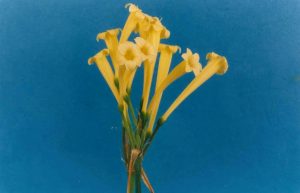
Cyrtanthus mackenii "Yellow"
We have improved upon the floral count (per stem) and, through selective breeding, have managed to get bigger and darker coloured flowers. This one is also easy to grow and enjoys being crowded in a pot.
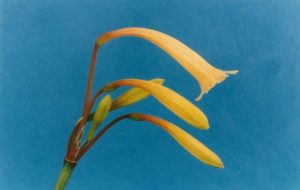
Cyrtanthus mackenii "Two Tone"
We have an interesting two-toned or two distinct different colours in this hybrid. The flowers are almost double the size of natural forms and the flower count often reaches 12 flowers per stem. Also, it often produces multiple stems per bulb.
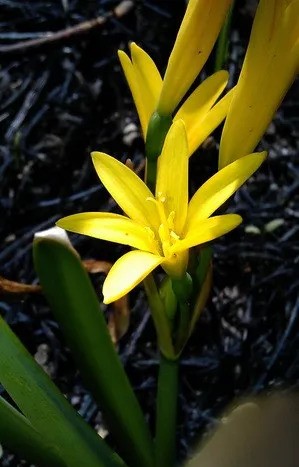
Cyrtanthus breviflorus (Evergreen form)
This bulb is interesting in that it is a water-loving, evergreen form of the Fire Lily. It is not stimulated into flowering by fire. It flowers naturally in a pot or in the ground and does equally well planted out on the margins of a pond. This is a very robust form that often gets 10 or more flowers and equally as often, gets multiple flower-heads.
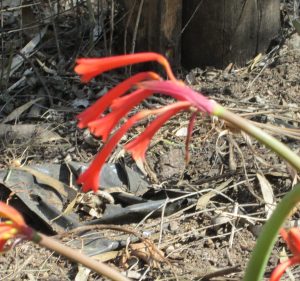
Cyrtanthus contractus - Orange Fire Lily
This is the famous Fire Lily of Southern Africa. It is a bright orange-red colour and has a flared face. The flowers are large and pendulous. It needs to be planted completely covered in soil and does not take kindly to being kept damp.

Cyrtanthus falcatus - Shepard's Crock
This huge Cyrtanthus is a show-stopper. It’s found growing anywhere from a desolate area behind a rock to mists from waterfalls to be completely covered up to the neck in soil or with just its roots covered, full sun or full shade. No matter where you plant it, in the springtime it will send up one or two stems with 180º bending just under the inflorescence, producing a profusion of big, variably red, yellow-or orange-coloured blooms. Frequently, the stems might reach a length of 600mm. It thrives in a pot (as do other Cyrtanthus). It is unaffected by a layer of frost or snow and can withstand winter temperatures as low as minus 20ºC.
